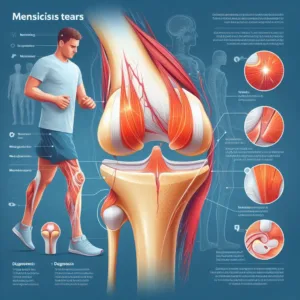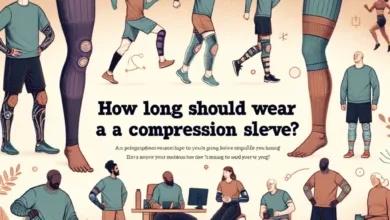Can You Run with a Torn Meniscus? Expert Insights and Recommendations

I’ve always had a love affair with running. The feeling of the wind in my hair and the pavement beneath my feet is exhilarating. But there’s always been a nagging fear lurking in my mind—the fear of injuries. One injury that often plagues runners is a meniscus tear, which can be incredibly painful and slow down your progress. So, when faced with this common question – Can You Run with a Torn Meniscus? –
I decided to delve into meniscus tears and find some answers. In this article, we’ll explore what exactly a meniscus tear is, how it affects your ability to run, and whether or not you should lace up those running shoes. So, let’s get started and put those fears to rest once and for all!
Contents
- 1 Understanding the Meniscus
- 2 The Big Question: Can You Run with a Torn Meniscus?
- 3 Risks of Running with a Torn Meniscus
- 4 Listening to Your Body: Signs You Shouldn’t Ignore
- 5 Recovery and Returning to Running
- 6 Tips for Runners: Preventing Meniscus Tears and Other Injuries
- 7 Conclusion: Can You Run with a Torn Meniscus?
- 8 FAQ’s:
Understanding the Meniscus
A Quick Overview The meniscus, a frequently misinterpreted component of the knee, is essential for preserving joint stability and averting damage. This resilient patch of cartilage, which resembles a crescent moon, serves as a stress absorber between the shinbone (tibia) and thigh bone (femur). Its primary purpose is to disperse the weight and forces used during motion, lowering friction and shielding the bones from undue abrasion. Consider it the cushion that lives inside your knee, providing painless, seamless movement.
Everyone should be aware of a few frequent causes of meniscus tears. First and foremost, abrupt twisting or pivoting motions made while participating in sports can severely strain the knee joint and cause a meniscus rupture. Take heed, all you weekend warriors out there! The age-related deterioration is another factor. Our menisci are more prone to tearing with even little force as we age because they are more vulnerable to wear and tear. Not to mention the daily repeated motions we put our knees through, such as squatting a lot at work or performing the same workouts repeatedly without a break. These actions can weaken the meniscus over time and eventually cause a rupture.
The Big Question: Can You Run with a Torn Meniscus?

You recently tore your meniscus, so can you still run on the pavement? To cut right to the chase, while it could be better, it’s also not totally out of the question. Listening to your body and getting medical advice before running when you have a meniscus tear is vital because it can exacerbate your injury. They will be able to determine the extent of your tear and offer advice on whether or not running is right for you. Always remember that taking care of your health should come first, even if it means putting your sneakers away to rest and recuperate.
https://kneecarex.com/how-to-heal-a-torn-meniscus-naturally/
Although it may appear difficult, running with a damaged meniscus is not impossible! Even with this bothersome injury, you can stay active and release endorphins by listening to your body and getting medical counsel. First and foremost, go gently at first. Avoid pushing yourself too quickly or too hard. If you want to offer your knee some respite while still getting a decent workout, use low-impact workouts like swimming or biking. Wear appropriate supporting footwear; if you want even more stability, consider wearing a brace. Remember the benefits of cross-training; include exercises like weightlifting and yoga to improve your flexibility and strength.
Risks of Running with a Torn Meniscus

Regarding injuries, running can be a double-edged sword at times. Although it is a great method to maintain an active lifestyle, it can also worsen pre-existing ailments. Imagine enjoying a leisurely morning run as the concrete feels under your feet and the wind tousles your hair. You suddenly have stabbing pain through your ankle or knee. Running aggravates the pain despite your efforts to ignore it and believe it to be a passing inconvenience. Repeated motion and constant impact can strain already-weakened muscles or joints, causing more harm. Running may seem like the ideal way to unwind, but you need to pay attention to your body and give yourself time to recover before stepping onto the pavement again.
There is a difference between running with a slight tear and a large one. Both can be uncomfortable and need care, but how severe the rip is can significantly impact how quickly you heal and how well you feel overall. A little tear may cause discomfort and require you to rest for a while, but recovery time is usually not too long. But when you have a large tear, things quickly get very bad. This type of injury necessitates rigorous treatment and rehabilitation and can keep you out of commission for weeks or even months.
Listening to Your Body: Signs You Shouldn’t Ignore
Are you sick of coping with that bothersome meniscus ache each time you walk on the pavement? I understand the struggle, I promise! Running should be enjoyable, but it can soon become tedious when your knee starts to give you trouble. That dull aching or sharp twinge could seriously hamper your fitness objectives in your meniscus. But do not worry, dear friend! Treatments are available to assist in reducing this discomfort and allow you to resume enjoying your runs worry-free.
Have you ever run and then had a hurting meniscus? It’s undoubtedly an unpleasant sensation that can seriously interfere with your exercise regimen. Knee discomfort can irritate whether you’re a novice runner or an avid one. But rest assured—you’re not by yourself! The identical problem has been encountered by many runners, who have discovered solutions. We’ll look at several strategies in this post for treating a meniscus tear so you can quickly resume pounding the pavement. So, let’s get started by putting on our sneakers!
Recovery and Returning to Running

You recently tore your meniscus, and now all you can think about is when you can get back on the road for that thrilling run. My eager friend, the truth is more complex than we’d like it to be. Following a meniscus tear, the amount of time you can resume running will depend on several variables, including the extent of the tear, how quickly you heal, and advice from your healthcare provider. I understand that waiting can seem endless, but it’s important to put safety before impatience.
After a meniscus tear, getting back into running can be an exhilarating and difficult experience. The important thing is to proceed cautiously and one step at a time. First, know if you’re prepared for the comeback by speaking with your physician or physical therapist. They will lead you through a customized rehabilitation program that consists of exercises to increase your flexibility and muscular strength. Begin with low-impact exercises like swimming or walking, then progressively work up to jogging and running. Avoid overexerting yourself because this can result in setbacks. Paying attention to your body and taking days off when necessary is also very important.
Tips for Runners: Preventing Meniscus Tears and Other Injuries
Not only are warm-ups and cool-downs optional during your workout, but they are also essential for maximizing your results and avoiding injury. Consider them as the workout session’s bookends, assisting your body in getting ready for the challenges ahead and enabling it to recover into a resting condition afterward. Warm-ups stimulate blood flow, raise body temperature, and relax muscles, increasing their flexibility and reducing the likelihood of strains or pulls. Conversely, cool-downs assist in flushing waste products from your muscles, reduce lightheadedness, and gradually lower your pulse rate.
Check Also: How to Heal a Torn Meniscus Naturally: A Comprehensive Guide
Are you sick of having pains in your feet after every run?

It all comes down to striking that fine balance when deciding whether to take a break and when to keep going. Everybody has been in that situation where they had to choose between pushing themselves and rest. But trust me when I say that you must pay attention to your body and what it’s trying to tell you. Sometimes, perseverance pays off, resulting in amazing discoveries and accomplishments.
Conclusion: Can You Run with a Torn Meniscus?
We covered several important things during our conversation that provided clarification on the subject at hand. We began by discussing how crucial good communication is to creating lasting bonds with others. We may genuinely engage with people and create lasting connections using our active listening abilities and awareness of non-verbal signs. We also looked at empathy’s role in fostering harmony among varied cultures and comprehending other points of view. We also stressed the importance of an open mind since it helps us accept new concepts and share knowledge.
Greetings, fellow bookworms! Today, I want to discuss listening to our bodies—a crucial and frequently disregarded topic. Our bodies are amazing machines that can communicate their needs to us. Let’s make a deal now: you swear to me that you will begin to pay attention to the subtle cues your body gives you. It’s important to take more than just Dr. Google into consideration if something doesn’t feel quite right. Consult a healthcare physician for professional guidance to point you in the proper route.
Running brings me genuine joy and excitement, helping me stay in shape. The sensation of your feet striking concrete has a charm that makes you feel like you’re gliding through the air with grace and ease, not to mention the endorphin surge accompanying each step! But amid all this enthusiasm, we can’t undervalue the significance of avoiding injuries. I promise you, nothing is more annoying than having a sore muscle or persistent pain keep you from doing what you want to do. Thus, stretch correctly, pay attention to your body, choose quality shoes, and refrain from overexerting yourself. Running should, after all, be enjoyable from beginning to end!
FAQ’s:
Can you walk or run with a torn meniscus?
Having a meniscus tear might make it difficult to run or walk. Patients who cry a little bit can be guided by a physical therapist to walk or run. Walking without crutches may result in more harm in cases of serious tears. The size, location, health, and level of fitness of the tears all influence the recommendations. Wearing knee braces and going one step at a time can help assist the recovering person.
What does a torn meniscus feel like from running?
Similar to a rapid twist or pop sensation in a drawer, a torn meniscus can generate abrupt and uncomfortable sensations in the knee during jogging. Your usual run may be interrupted by this unexpected disturbing sensation, which will cause your movements to unwelcomely stop. In the event that you encounter such symptoms whilst running, it is imperative that you seek prompt medical assistance.
How long does it take for a torn meniscus to heal without surgery?
Without surgery, a torn meniscus can mend in anywhere from six weeks to three months. A key component of recovery is physical therapy, which involves carefully planned exercises to preserve range of motion and reduce discomfort. Rushing could cause things to move more slowly, so patience is key. It’s critical to go cautiously at first.
How can I exercise with a torn meniscus?
Creative and safe activities might help you stay physically fit even with a damaged meniscus. Swimming and aqua jogging are examples of water-based exercises that can lessen knee joint strain and maintain cardiovascular fitness. Another useful activity is low-impact strength training that targets the hamstrings and quads. Adaptation rather than resignation is what adjustment entails.




